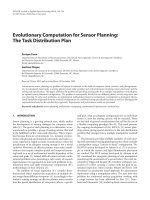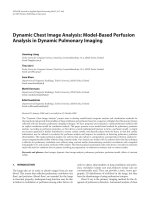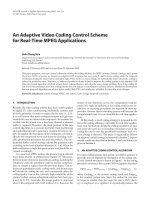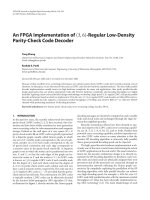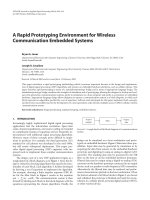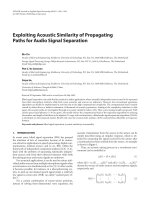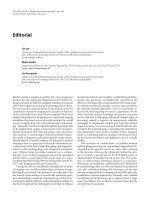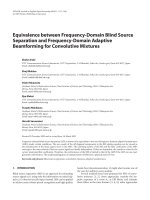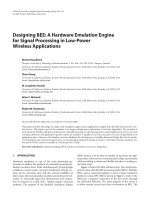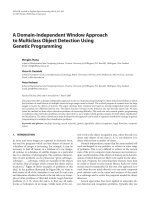EURASIP Journal on Applied Signal Processing 2003:13, 1268–1278 c 2003 Hindawi Publishing ppt
Bạn đang xem bản rút gọn của tài liệu. Xem và tải ngay bản đầy đủ của tài liệu tại đây (764.58 KB, 11 trang )
EURASIP Journal on Applied Signal Processing 2003:13, 1268–1278
c
2003 Hindawi Publishing Corporation
Extended Kalman Filter Channel Estimation
for Line-of-Sight Detection in WCDMA
Mobile Positioning
Abdelmonaem Lakhzouri
Institute of Communications Engineering, Tampere University of Technology, P.O. Box 553, 33101 Tampere, Finland
Email: abdelmonae m.lakhzouri@tut.fi
Elena Simona Lohan
Institute of Communications Engineering, Tampere University of Technology, P.O. Box 553, 33101 Tampere, Finland
Email: elena-simona.lohan@tut.fi
Ridha Hamila
Etisalat College of Engineering, Emirates Telecommunications Corporation, P.O. Box 980, Sharjah, UAE
Email:
Markku Renfors
Institute of Communications Engineering, Tampere University of Technology, P.O. Box 553, 33101 Tampere, Finland
Email: markku.renfors@tut.fi
Received 21 October 2002 and in revised form 29 May 2003
In mobile positioning, it is very important to estimate correctly the delay between the transmitter and the receiver. When the re-
ceiver is in line-of-sight (LOS) condition with the transmitter, the computation of the mobile position in two dimensions becomes
straightforward. In this paper, the problem of LOS detection in WCDMA for mobile positioning is considered, together with joint
estimation of the delays and channel coefficients. These are very challenging topics in multipath fading channels because LOS
component is not always present, and when it is present, it might be severely affected by interfering paths spaced at less than one
chip distance (closely spaced paths). The extended Kalman filter (EKF) is used to estimate jointly the delays and complex channel
coefficients. The decision whether the LOS component is present or not is based on statistical tests to determine the distribution
of the channel coefficient corresponding to the first path. The statistical test-based techniques are practical, simple, and of low
computation complexity, which is suitable for WCDMA receivers. These techniques can provide an accurate decision whether
LOS component is present or not.
Keywords and phrases: extended Kalman filter, fading statistics, LOS detection, mobile positioning, WCDMA systems.
1. INTRODUCTION
For the public interest, mobile phone positioning in a cellu-
lar network with reliable and rather accurate position infor-
mationhasbecomeunavoidableaftertheFederalCommu-
nications Commission mandate, FCC-E911 docket on emer-
gency call positioning in USA, and the coming E112 in the
European Union [1]. One method for locating the mobile
station (MS) in two dimensions requires the measurement
of line-of-sight ( LOS) distance between the MS and at least
three base stations (BSs). Hence, knowing which BS is re-
porting, LOS component is crucial for accurate position esti-
mation. In many cases, the non-LOS (NLOS) sig nal compo-
nents, arriving with delay less than one chip at the receiver,
obscure the LOS signal. This situation of overlapping multi-
path propagation is one of the main sources of mobile p osi-
tioning errors [2, 3, 4].
Previous studies dealing with LOS detection used range
measurement-based techniques [5, 6, 7] (i.e., measurements
of the time of arrival), which exploit the time history of the
range measurements and the a priori knowledge of the noise
floor in the system. These techniques can increase the ac-
curacy of the mobile position estimation, but they require
the knowledge of the a priori statistic parameters such as
the standard deviation of the measurement noise. The use
of a link level-based techniques where the signal processing
EKF Channel Estimation for LOS Detection in WCDMA Mobile Positioning 1269
is made in the MS side as presented in this paper to de-
tect whether the LOS component is present or not is a new
topic. In this paper, accurate estimates of the channel co-
efficients and their corresponding delays in the context of
closely spaced paths are obtained using extended Kalman fil-
ter (EKF) algorithm, aided by an interference cancellation
(IC) technique. The channel coefficients will be used as basis
for deciding whether the first arriving path is a LOS or NLOS
component.
Many techniques were presented to cope with closely
spaced multipath propagations, such as subspace-based
methods [8] or least square (LS) approaches [9, 10]. These
techniques can provide rather accurate estimation of the
multipath delays, but they suffer from the high complex-
ity for the implementation in WCDMA systems in tracking
mode. Few authors have studied the problem of joint param-
eters estimation using Kalman filtering in multipath fading
and multiuser environment. In [11], Iltis has developed a
new technique for jointly estimating the channel coefficients
and the first-path delay in frequency selective channel based
on Kalman filtering in a single user system. Recently, the
idea has been extended to multiuser scenario [12]. In order
to solve the closely spaced multipaths, we propose here an
EKF-based solution with IC scheme. EKF algorithm jointly
estimates the delays and complex coefficients of all the paths
from all the participating BSs and it is combined with a new
IC scheme to enhance the estimation of the channel from the
desired BS (serving BS). The obtained estimates are used to
detect whether the LOS component is present or not. The
detection procedure exploits the distribution of the first ar-
riving path. If the dist ribution is Rician with strong Rician
factor, then LOS component is likely to be present. If the dis-
tribution is Rayleigh, it is more likely that LOS component
is absent. We point out that the proposed algorithm is not
limited to a WCDMA system and it can be easily extended to
other mobile positioning systems.
This paper is organized as follows. In Section 2, the chan-
nel and signal model are described. Then, the joint estima-
tion of the channel coefficients and delays is described in
Section 3 with an emphasis on the proposed IC algorithm.
Section 4 is devoted to the novel LOS detection procedures.
Simulation results are provided in Section 5 , and conclusions
are drawn in Section 6.
2. CHANNEL AND SIGNAL MODELS
The system under consideration is a DS-CDMA system with
N
BS
base stations and N
u
users per BS. In baseband system
(fully digital implementation), the received signal complex
valued at sample level, transmitted over an L-path fading
channel, can be written as [13]
r(i) =
∞
m=−∞
N
BS
u=1
L
l=1
E
b
u
α
l,u
(m)s
(m)
u
iT
s
− τ
l,u
(m)
+ η(i),
(1)
where i is the sample index (we assume that there are N
s
samples per chip), E
b
u
is the bit energy of the uth BS (we
assume that all bits of the same BS have the same energy),
L is the number of discrete multipath components, T
s
is the
sampling period (T
s
= T
c
/N
s
, T
c
is the chip period), α
l,u
(m)
and τ
l,u
(m) represent, respectively, the complex-valued time
var ying channel coefficient and delay of the lth path of base
station u, during the mth symbol. The delays are treated as
complex values, but only the magnitudes rounded to the
nearest integer values are retained. We denote by s
(m)
u
(·)
the signature of the uth BS during symbol m including
data modulation, spreading code, and pulse shaping, and η
is an additive circular white Gaussian noise of zero mean
and double-sided spectral power density N
0
. The signatures
of all users are assumed to be known at the receiver (this
corresponds to a situation when a pilot signal is available,
e.g., Common Pilot Channel (CPICH) signal in downlink
WCDMA environment [14]). The intracell interference is as-
sumed Gaussian distributed by virtue of central limit theo-
rem, and it is included in the term η(·).
The output of the matched filter corresponding to the de-
sired BS u during the symbol n with lag τ is as follows:
y
u
(n, τ) =
N
BS
v=1
L
l=1
E
b
v
α
l,v
(n)
u,v
τ − τ
l,v
(n)
+
˜
η(n), (2)
where
u,v
(·) is the cross correlation between the signature
of the BS of interest (uth BS) and the signature of the vth
BS,
˜
η(n) is the filtered noise plus interchip and intersymbol
interference, and α
l,v
(n)andτ
l,v
(n) are the complex chan-
nel coefficients and the path delays, respectively, at symbol
level. We point out that the channel coefficients and de-
lays are assumed to be constant within one symbol. This as-
sumption is reasonable since the symbol period (e.g., 66.5 µs
for S
F
= 256) is much less than the coherence time of the
channel. The constant delays assumption is also reasonable
for terrestrial communications due to the negligible Doppler
shift. The channel coefficients and delays are modeled as a
Gauss-Markov process [11, 12, 15]
α
l,v
(n +1)= β
v
α
l,v
(n)+w
α
l,v
(n),
τ
l,v
(n +1)= γτ
l,v
(n)+w
τ
l,v
(n),
(3)
where w
α
and w
τ
are mutually independent additive circular
white Gaussian noise processes, γ is a coefficient accounting
for the delay variation, and β
v
is a coefficient accounting for
the maximum Doppler spread, f
D
, of the vth BS, defined as
[16]
β
v
= I
0
2πf
D
T
sym
, (4)
where I
0
(·) is the zero-order Bessel function and T
sym
is the
symbol interval. We assumed that for each BS, all the paths
have the same maximum Doppler spread. The coefficient β
v
is close to unity when the Doppler spread is significantly less
than the Nyquist bandwidth. We assume here that the coef-
ficient γ is constant for all the BSs and all the paths. This is
a reasonable assumption in terrestrial communication when
the Doppler shift is negligible, and γ can be set to a value
close to unity for all multipath delays of all users. However,
1270 EURASIP Journal on Applied Signal Processing
EKF can be easily modified to use different γ coefficients [12].
We point out that the channel models of [11, 12, 17] are dif-
ferent from (3) in the sense that, earlier, the paths have been
assumed uniformly spaced at chip period (T
c
), and the only
delay modeled with (3) is the delay of the first path. In this
paper, we derive an extension of the EKF model for all the
path delays. This should not affect the EKF algorithm; it will
only increase slightly the number of parameters to be esti-
mated, and hence, the complexity. Also, we point out that the
Gaussian assumption of multiple access interference (MAI)
can be relaxed and the algorithm is straightforward to ex-
tended to non-Gaussian MAI case by using some IC within
each cell in a similar manner to the intercell IC algorithm
presented in the next section.
3. JOINT CHANNEL COEFFICIENTS AND PATH
DELAYS ESTIMATION
The joint estimation of multipath delays and complex chan-
nel coefficients of the serving BS is done in two steps. First, we
jointly estimate all the path delays and channel coefficients
from all par ticipating BSs, which leads to an estimation of
the interference due to CPICH channels. Then, an IC scheme
will be combined to enhance the estimation of the desired BS
(serving BS) channel. During the first step, the discrete state
vector , x (n) ∈ C
2LN
BS
×1
, associated with al l BSs is defined by
x(n) =
x
1
, ,x
N
BS
T
, (5)
where x
v
= [α
1,v
(n), ,α
L,v
(n),τ
1,v
(n), ,τ
L,v
(n)], for v =
1, ,N
BS
. Due to the fact that the received signal is not a lin-
ear function of the multipath delays τ
l,v
, an EKF is needed.
The state and observation models are described by the fol-
lowing equations, respectively,
x(n +1)= Fx(n)+w(n),
z(n) = Ᏼ
x(n)
+ ν(n),
(6)
where w(·)andν(·) are circular white Gaussian noise pro-
cesses, F ∈ R
2LN
BS
×2LN
BS
is defined by F = Block diag(F
1
, ,
F
N
BS
), where F
v
= diag(β, ,β,γ, ,γ), z(n) is the obser-
vation vector which depends nonlinearly on the state vector
x(n), z(n) = [y
1
(n), ,y
N
BS
(n)]
T
, and the nonlinear trans-
form Ᏼ(·)isgivenasfollows:
Ᏼ
x(n)
=
H
1
x(n)
, ,H
N
BS
x(n)
T
, (7)
where H
i
(x(n)) =
N
BS
v=1
L
l=1
E
b
v
α
l,v
(n)
i,v
(nT
sym
−τ
l,v
(n)),
for i = 1, ,N
BS
.
Here, we assume that we have no data modulation, which
is true for the CPICH reference channels used for positioning
in WCDMA [14]. However, this assumption is not crucial
in the sense that data can be removed in a decision-directed
mode before we proceed with EKF estimation. The circular
white Gaussian noise vector w(·)isdefinedas
w(n) =
w
1
(n), ,w
N
BS
(n)
T
, (8)
where w
i
(n) = [w
α
0,i
, ,w
α
L−1,i
,w
τ
0,i
, ,w
τ
L−1,i
].
The EKF algorithm requires the linearization of the
transform Ᏼ(·). The most common linearization method
used is the first-order Taylor expansion defined as follows
[11, 17, 18]:
Ᏼ
x(n)
≈ Ᏼ
ˆ
x(n|n − 1)
+
2LN
BS
m=1
x
m
(n) −
ˆ
x
m
(n|n − 1)
×
∂
∂x
m
Ᏼ
x(n)
x(n)=
ˆ
x(n|n−1)
,
(9)
where
ˆ
x(n|n −1) is the predictor at step n conditional to pre-
vious observations, x
m
(n) are the elements of the state vector
x(n), and
ˆ
x
m
(n|n−1) are the elements of the predictor vector
ˆ
x(n|n − 1), m = 1, ,2LN
BS
.
Using the linearization in (9), the set of EKF equations
can be written as [11, 12, 17]
ˆ
x(n|n) =
ˆ
x(n|n − 1) + K(n)
z(n) − Ᏼ
ˆ
x(n|n − 1)
,
K(n) = P(n|n − 1)Ᏼ
(n)
Ᏼ
(n)
H
P(n|n − 1)Ᏼ
(n)+Σ
ν
−1
,
P(n|n) =
I − K(n)Ᏼ
(n)
H
P(n|n − 1).
(10)
Here, Σ
ν
is the covariance matrix of the measurement noise
and Ᏼ
(n) is the partial derivative matrix
Ᏼ
(n) =
Ᏼ
1
, ,Ᏼ
N
BS
, (11)
where
Ᏼ
i
=
∂Ᏼ
ˆ
x(n|n − 1)
∂
ˆ
x
1,i
, ,
∂Ᏼ
ˆ
x(n|n − 1)
∂
ˆ
x
L,i
,
∂Ᏼ
ˆ
x(n|n − 1)
∂
ˆ
x
L+1,i
, ,
∂Ᏼ
ˆ
x(n|n − 1)
∂
ˆ
x
2L,i
H
.
(12)
To ensure real and integer values for the estimated delays,
ˆ
x
j,i
(·) are the rounded to the nearest integer value of |τ
j,i
(·)|
for j = L +1, ,2L,andfori = 1, ,N
BS
. The one step
predictions of the state vector and error covariance matrix
satisfy, respectively,
ˆ
x(n +1
|n) = F
ˆ
x(n|n),
ˆ
P(n +1|n) = F
ˆ
P(n|n)F
T
+ Q,
(13)
where Q = Block diag(Q
1
, ,Q
N
BS
)and
Q
i
= diag
σ
2
w
α
0,i
, ,σ
2
w
α
L−1,i
,σ
2
w
τ
0,i
, ,σ
2
w
τ
L−1,i
. (14)
When the first stage of estimating all the path delays and
channel coefficients is achieved, it becomes possible to esti-
mate the interference
ˆ
y
int
(n, τ) coming from the nonserving
BSs (we suppose that the serving BS has the index 1):
ˆ
y
int
(n, τ) =
N
BS
v=2
L
l=1
E
b
v
ˆ
α
l,v
(n)
1,v
τ −
ˆ
τ
l,v
(n)
. (15)
To refine the estimation of the desired BS channel, we cancel
EKF Channel Estimation for LOS Detection in WCDMA Mobile Positioning 1271
the estimated interference
ˆ
y
des
(n, τ) = y
1
(n, τ) −
ˆ
y
int
(n, τ), (16)
and, then, we introduce a second estimation stage based on
EKF with a state vector x
des
(n) ∈ C
2L×1
and with an obser-
vation vector z
des
(n) given, respectively, by
x
des
(n) =
α
1,1
(n), ,α
L,1
(n),τ
1,1
(n), ,τ
L,1
(n)
T
,
z
des
(n) =
ˆ
y
des
(n).
(17)
The EKF set of equations for single BS channel estima-
tion can be retrieved easily from the equation presented for
multiple BSs case. In this algorithm, we try to cancel only
the interference coming from other BSs (interference due to
CPICH channels). The interference coming from the other
users (i.e., DPCH channels [14]) is considered as additive
white noise and it will be neglected by the IC algorithm for
simplicity. To cancel the intracell interference, the spreading
codes of all users should be known by the receiver. Besides,
in WCDMA systems, CPICH power is usually significantly
higher than the individual DPCH power [14]. Therefore, us-
ing only intercell interference in the interference canceller is
reasonable.
4. LOS DETECTION
The probability density function (pdf) of a fading channel
with amplitude |α| which relates the Rayleigh, Rician, and
Nakagami distributions is given by [19]
p
r
|α|, Ω,K
r
=
2|α|
1+K
r
Ω
exp
−K
r
−
|α|
2
1+K
r
Ω
I
0
×
2|α|
K
r
1+K
r
Ω
,
(18)
where Ω is the average fading power, Ω = E[|α|
2
], and K
r
is the Rician factor. For K
r
= 0, the pdf becomes Rayleigh
distribution and it is Nakagami-n when n
2
= K
r
. We point
out here that the Rayleigh distribution is a particular case
of Nakagami and Rician for n
2
= K
r
= 0. The question is
how to detect the LOS and NLOS situations. This detection
problem can be redefined in terms of a statistical test. First,
we estimate {(α
i,1
,τ
i,1
), i = 1, ,N
BS
} with the EKF algo-
rithm. Then, by using statistic tests, we check if the channel
is Rayleigh or not.
The most straightforward method is to estimate the pdf
of the first arriving path, and compare it to some reference
pdfs such as Rayleigh, Rician, Normal, Lognormal. To esti-
mate correctly the distribution of the first arriving path, a set
of independent fading coefficients are needed. The fading co-
efficients can be considered independent if they are at least a
coherence time (∆t
coh
) apart. When the car rier frequency is
2.15 GHz, and for a mobile velocity v in m/s, the coherence
time is [20]
∆t
coh
=
9
16πf
D
0.025
v
. (19)
In WCDMA mobile positioning, two techniques have been
proposed to let the MSs measure different BSs within their
coverage. The first one is the idle period-downlink (IP-DL)
transmission proposed in [21].ItimposestoeachBStoturn
off its transmission for a well-defined period of time to let the
MSs measure other BSs. In this case, the MS cannot measure
continuously all the links, and the number of independent
points sufficient for the positioning can be only acquired
from the serving BS. As an alternative to IP-DL method,
Jeong et al. [22]proposedanICschemeinconjunctionwith
the delay lock loops (DLLs) to reduce the intercell interfer-
ence. By using this technique, the MS can measure continu-
ously all the BSs in its coverage. In our algorithm, we use the
EKF-based IC scheme to be able to measure continuously all
available links.
We consider that N independent values are available in
the MS memory to be used in the estimation of the channel
distribution whenever the positioning is needed. For these N
independent points x
i
, we test the hypothesis that P
df
= Q
df
,
where P
df
is the measured pdf and Q
df
is the reference pdf
(e.g., Rayleigh, Rician, etc.). We define the two states H
0
and
H
1
, respectively, such that [23]
P
df
x
i
= Q
df
x
i
for 1 ≤ i ≤ N,
P
df
x
i
= Q
df
x
i
for some i.
(20)
We introduce the m events X
i
={x
i−1
<x≤ x
i
}, i =
1, ,m,wherex
0
=−∞and x
m
= +∞.Wedenotebyk
i
the
number of successes of X
i
, that is, the number of samples in
the interval [x
i−1
,x
i
].
Under the hypothesis H
0
,
P
X
i
= P
df
x
i
= Q
df
x
i
,
p
i0
=
x
i
− x
i−1
P
X
i
.
(21)
Thus, to test the hypothesis, we form the Pearson’s test statis-
tic (PTS) [23]
PTS
=
m
i=1
k
i
− np
i0
2
np
i0
, (22)
where n is the total number of observed samples (n
∼
=
N∆t
coh
). The hypothesis H
0
is accepted if the PTS value sat-
isfies PTS <χ
2
1−λ
(m− 1), where χ
2
1−λ
(m− 1) is taken from the
standard chi-square tables corresponding to the confidence
level λ and to the degree of freedom (m − 1).
This technique is efficient when the observation interval
is long enough, the simulation results showed that around 1
second is needed to make reliable decision for a mobile veloc-
ity of 22.22 m/s. To decrease the duration of the observation
and hence the hardware needed for storage, we propose a new
algorithm using the estimation of Rician factor parameter K
v
r
with respect to the channel profile of the vth BS defined by
[20]
K
v
r
=
µ
2
2σ
2
, (23)
1272 EURASIP Journal on Applied Signal Processing
For i = 1, ,N
BS
,
Compute K
(i)
r
(dB)
Evaluate P
(i)
NLOS
and P
(i)
LOS
Evaluate d
i
= P
(i)
LOS
− P
(i)
NLOS
if d
i
> 0, then LOS component is present from BS
i
with probability P
(i)
LOS
.
else, LOS component is absent from BS
i
with probability P
(i)
NLOS
.
Next BS.
Algorithm 1: Rician factor-based LOS detection.
R
signal
User
signature
I&D
TK operator or
POCS processing
|·|
2
Noncoherent
integration
Block
averaging
Detection
threshold
Threshold
computation
Decision
Figure 1: Block diagram of the acquisition model.
where µ =|E[α
1,v
]| and σ
2
= Var[α
1,v
]/2. Hereinafter, we
consider the case of single BS and the subscript v will be
dropped for convenience. In multiple BSs case, the same pro-
cedure is repeated for each BS. We point out that when K
r
is
zero , µ is also zero and Rayleigh distribution should be de-
tected. To distinguish between Rayleigh and Rician cases, we
divide the whole range of K
r
, in dB scale, into three regions:
region I: [−∞,B
min
], region II: [B
min
,B
max
], and region III:
[B
max
, +∞], where B
min
and B
max
are two predefined param-
eters, which depend on the level of noise in the system.
If K
r
(dB) ∈ region I, then the distribution is Rayleigh and
we set the probability (P
NLOS
,P
LOS
)to(1.0, 0.0), if K
r
(dB) ∈
region III, then the distribution is Rician and we set the prob-
ability (P
NLOS
,P
LOS
)to(0.0, 1.0), and if K
r
(dB) ∈ region II,
then the probabilities P
NLOS
and P
LOS
are computed as follow.
The range [B
min
,B
max
] is divided into (M +1)equally
spaced intervals [b
i−1
,b
i
], where b
0
= B
min
and b
M+1
=
B
max
.Ifb
i−1
≤ K
r
(dB) ≤ b
i
, then we set the probability
(P
NLOS
,P
LOS
)to((M − i +1)/M, (i − 1)/M). This technique
is simple to implement and provides accurate detection of
the LOS component. The simulation showed that around
10 milliseconds are needed to detect accurately the distri-
bution of the first arriving path. The algorithm for LOS de-
tection based on the measurement from all BSs is shown in
Algorithm 1.
5. SIMULATION RESULTS
The EKF-based estimation was simulated in tracking mode.
We assume that the initial multipath delay estimates are
within N
init
samples away from the true delays, where N
init
≤
N
s
. The acquisition of the closely spaced multipath delays can
be done with a separate feed-forward acquisition based on
correlation and additional signal processing such as the non-
linear Teager Kaiser (TK) operator-based estimation [24], the
iterative LS-based algorithms, projection onto convex sets
(POCS) [9, 10, 25], or the pulse subtraction (PS)-based algo-
rithms [26, 27]. The simulation results showed that the most
promising algorithms are TK and POCS. Figure 1 shows the
block diagram of the acquisition model including the addi-
tional signal processing.
The discrete-time TK operator applied to a complex sig-
nal x(n)isgivenby[27, 28]
Ψ
d
x( n)
= x(n − 1)x(n − 1)
∗
− 0.5
x( n − 2)x(n)
∗
+ x(n)x(n − 2)
∗
.
(24)
TK exploits the structure of the cross-correlation function to
estimate the subchip-spaced multipath components [24, 28].
The POCS algorithm is a constrained deconvolution ap-
proach, originally proposed in [9, 25] for delay estimation
in Rake receivers, under the assumption of rectangular pulse
shapes. If we reformulate (2) into a vectorial form, it is pos-
sible to write the following expression:
y
u
(n) = G
u,u
h
u
(n)+v
η
(n), (25)
where y
u
(n) is the vector of correlation outputs correspond-
ing to the uth BS, at different time lags between 0 and max-
imum channel delay spread τ
max
T
s
.Itisdefinedasy
u
(n) =
[y
u
(n, 0), ,y
u
(n, τ
max
T
s
)]
T
∈ C
(τ
max
+1)×1
.ThematrixG
u,u
is the pulse shape deconvolution matrix with element g
i,j
=
E
b
u
u,u
(i − j), for i, j = 0, ,τ
max
, v
η
(n) is the sum
of Inter-Chip-Interference (ICI), Inter symbol Interference
(ISI), MAI, and AWGN noises after the despreading opera-
tion. The vector h
u
(n)ofelementsh
l,u
is defined such that
EKF Channel Estimation for LOS Detection in WCDMA Mobile Positioning 1273
Near-far ratio (P
interferers
/P
desired
) (dB)
−20 −15 −10 −50 5101520
Probabilty of acquisition within 1 chip
0.1
0.2
0.3
0.4
0.5
0.6
0.7
0.8
0.9
1
TK
POCS
PS
(a) Acquisition probability of first path.
Near-far ratio (P
interferers
/P
desired
) (dB)
−20 −15 −10 −50 5101520
Probability of acquisition within 1 chip
0.1
0.2
0.3
0.4
0.5
0.6
0.7
0.8
TK
POCS
PS
(b) Acquisition probability of all paths.
Figure 2: Probability of acquisition within 1 chip in closely spaced multipaths downlink WCDMA transmission using TK, POCS, and PS
algorithms, N
BS
= 3, N
u
= 32, S
F
= 256, N
s
= 8, L = 5, and E
b
/N
0
= 10 dB.
h
l,u
= 0 if no multipath is present at the time delay l,and
h
l,u
= α
l,u
if the index l corresponds to a true path loca-
tion. Therefore, resolving multipath components refers to
the problem of estimating the nonzero elements of the un-
known gain vector h
u
(n).ThePOCSestimationisanitera-
tive process. The estimates at the (k + 1)th iteration can be
written as [10]
˜
h
u
(n)
(k+1)
=
˜
h
u
(n)
(k)
+
1
λ
POCS
I + G
H
u,u
G
u,u
−1
× G
H
u,u
y
u
(n) − G
u,u
˜
h
u
(n)
(k)
,
(26)
where λ
POCS
is a constant determining the convergence speed
and I is the unity matrix. The threshold used in the multipath
detection is set adaptively, based on the estimation of sig nal-
to-noise ratio (SNR) in the system [29].
Figure 2 shows the probability of acquiring the first path
(plot “a”) and acquiring all the paths (plot “b”) within 1
chip error using TK, POCS, and PS algorithms. The chan-
nel profile is Rayleigh with probability p
R
= 0.9andRician
with exponential distribution Rician fac tor of mean µ
R
= 4
with probability 0.1. The channel has 5 paths with average
powers 0, −2, 0, −1, and −3 dB. The acquisition probability
is computed over N
rand
random realizations of the channel,
N
rand
= 150. We see that at low Near Far Ratio (NFR) val-
ues (up to 0 dB), it is possible to acquire all the paths within
1 chip in at least 60% of the cases with TK algorithm. How-
ever, the probability is much higher for the first path. This
proves that the assumption of initial delay error for the EKF
estimation within 1 chip is quite reasonable.
5.1. EKF for joint estimation with closely spaced paths
A downlink multiuser WCDMA scenario was considered
with L paths, the first one being either Rayleigh or Rician.
The channel is supposed to be Rayleigh with probability
p
R
and Rician with probability 1 − p
R
. The delay separa-
tion between successive paths are uniformly distributed in
[T
c
/N
s
; T
c
](N
s
= 8).
In Figure 3, we show the tracking trajectory of both de-
lays and channel coefficients of the first arriving path for L =
4, with tracking delay error initialized at N
init
= τ−
ˆ
τ = 0.5T
c
.
The matrix of the average path powers is
P
BS
=
0 −2 −2 −3
−1 −1 −4 −5
−2 −1 −4 −6
−2 −2 −4 −5
dB. (27)
The first row corresponds to the average path powers of the
desired BS. The simulation shows that EKF is able to track
quite accurately the delays and the complex channel coeffi-
cients by using the IC scheme. In Figure 4, we show the prob-
ability of acquiring correctly the delay of the first arriving
path within an error of 1 sample (1/N
s
chip) with and with-
out IC algorithm. The channel from each BS has 3 closely-
spaced paths. The corresponding average powers are
P
BS
=
0 −1 −4
−3 −2 −4
−1 −2 −4
−2 −2 −4
dB. (28)
1274 EURASIP Journal on Applied Signal Processing
Symbols
0 1020304050607080
Delay: path 1
20
22
24
26
Delay of the desired BS: path 1
Tru e del ay
Estimated delay: no IC
Estimated delay: with IC
(a)
Symbols
0 1020304050607080
Real of the coef.: path 1
−1.5
−0.5
0.5
1.5
Coefficients of the desired BS: path 1
Tru e coefficient
Estimated coefficient: no IC
Estimated coefficient: with IC
(c)
Symbols
0 1020304050607080
Delay RMSE: path 1
0
1
2
3
4
5
Without IC
With IC
(b)
Symbols
0 1020304050607080
Coef. RMSE: path 1
0
0.2
0.4
0.6
0.8
1
Without IC
With IC
(d)
Figure 3: EKF-based desired BS estimation for four closely spaced paths, N
BS
= 4, N
u
= 8, E
b
/N
0
= 10 dB, S
F
= 256, and N
s
= 8.
NFR (dB)
−20 −15 −10 −50 5101520
Probability of LOS acqui. within 1 sample error
0.1
0.2
0.3
0.4
0.5
0.6
0.7
0.8
0.9
With IC
Without IC
Figure 4: Probability of first arriving path acquisition within 1 sam-
ple error with and without IC. Three closely spaced fading channel
paths, N
BS
= 4, p
R
= 0.9, E
b
/N
0
= 8dB,S
F
= 256, N
s
= 8, N
u
= 32,
N
rand
= 200.
ThechannelprofilefromthedesiredBSisRayleighwith
probability p
R
= 0.9 and it is Rician with probability 0.1. The
Rician factor is exponentially distributed with mean µ
R
= 4.
The acquisition probability is computed over N
rand
random
realizations of the channel, N
rand
= 200. We can see that it
is possible to achieve 20% to 30% gain in the probability of
first-arriving path acquisition by using the IC algorithm at
low NFR values. The tracking of the first-arriving path can
be achieved in up to 80% of the cases with IC. However, at
high NFR, the feedback propagation error in EKF, when the
interference is strong, prevents the correct tracking of the de-
lay. The initial delay and covariance errors have a major effect
on the convergence of the EKF, that is, bad initialization may
lead to divergence of the algorithm.
5.2. LOS detection
First, we show the performance of PTS-based LOS detection.
Then, we show the performance of Rician factor-based al-
gorithm. We consider a relatively fast fading channel with
mobile velocity v = 80 km/h (22.22 m/s). In the statis-
tical test, the decision is made on N
slots
slots basis, with
N
slots
∈{50, 100, 500, 1000, 1500, 2000, 4000}. Independent
points spaced at ∆t
coh
apart are taken within the decision in-
terval. In WCDMA, 1 slot is t
slot
= 0.6667 milliseconds and
for S
F
= 256, there are 10 symbols per slot. The confidence
level in the decision was 99.99% [23]. Tabl e 1 shows the com-
parison of the measured data distribution of the first path
against several distributions: Rayleigh, Rician, Gaussian, and
Lognormal.
EKF Channel Estimation for LOS Detection in WCDMA Mobile Positioning 1275
Table 1: Probabilities of accepting a certain distribution with a confidence level of 99.99%. Rayleigh and Rician channels (K
r
= 15.5dB)and
v = 22.22 m/s.
Rayleigh channel N
slots
P
Rayleigh
P
Rician
P
Normal
P
Lognormal
Decision
50 0.993 1 1 0.83 None
100 0.993 1 0.98 0.76 None
500 1 1 0.86 0 None
1000 1 1 0.40 0 None
1500 1 1 0.10 0 NLOS
2000 1 1 0 0 NLOS
Rician channel N
slots
P
Rayleigh
P
Rician
P
Normal
P
Lognormal
Decision
50 1 1 1 0.04 None
100 1 1 1 0 None
500 1 1 0 0 NLOS
1000 1 1 0 0 NLOS
1500 0 1 0 0 LOS
2000 0 1 0 0 LOS
Amplitude values
00.511.522.533.5
0
0.01
0.02
0.03
0.04
0.05
0.06
0.07
0.08
Measured pdf
Rayleigh theoretical pdf
Rician theoretical pdf
(a)
Amplitude values
00.511.522.533.5
0
0.01
0.02
0.03
0.04
0.05
0.06
0.07
0.08
0.09
Measured pdf
Rayleigh theoretical pdf
Rician theoretical pdf
(b)
Figure 5: Estimated and theoretical Rayleigh and Rician pdfs for N
slots
= 500 (plot (a)) and N
slots
= 1500 (plot (b)). Rician channel profile
(K
r
= 15.5dB),v = 22.22 m/s.
When the channel is Rayleigh distributed (i.e., NLOS
case), we see that at least 1500 slots are needed to decide
Rayleigh and Rician. This is not contradictor y as the Rayleigh
distribution is a particular case of Rician. Hence, the overall
decision will be Rayleigh and the LOS component will be ab-
sent. If we use a lower number of slots (e.g., 100 slots), the
distribution cannot be established, as we also detect normal
distribution with probability 0.98, and Lognormal distribu-
tion with probability 0.76. Also, in the case of Rician chan-
nel profile (i.e., LOS case), at least 1500 slots are needed to
decide Rician distribution. We point out that for LOS case,
the statistical test for Rayleigh distribution should provide
P
Rayleigh
= 0. In this case, the number of independent points
needed for the decision is N = 880, which is obtained from
N = t
slot
N
slots
∆t
coh
. (29)
In Figure 5, we show the similarities between estimated pdf,
theoretical Rayleigh, and theoretical Rician pdfs when the
channel is Rician with N
slots
= 500 and N
slots
= 1500. We
can see that the measured data curve and Rician curve have
good fitting for the later case. This technique can be used
efficiently in continuous time measurement mode when the
mobile can keep track of the channel estimates over several
1276 EURASIP Journal on Applied Signal Processing
Slot index
0 400 800 1200 1600 2000
K
r
(dB)
0
5
10
15
20
25
30
35
40
(a)
Slot index
0 400 800 1200 1600 2000
d = P
LOS
− P
NILOS
0.1
0.2
0.3
0.4
0.5
0.6
0.7
0.8
0.9
1
(b)
Figure 6: Estimated Rician factor K
r
(plot (a)) and the probability distance d (plot (b)). Channel profile Rician with K
r
= 15.5dB and
v = 22.22 m/s.
Table 2: Probabilities of accepting a certain distribution using Ri-
cian factor-based algorithm. Rayleigh and Rician channel (K
r
=
15 dB) and v = 22.22 m/s.
Rayleigh channel N
slots
p
NLOS
p
LOS
d
mean
Decision
10.0917 0.9083 0.8165 LOS
10 0.5760 0.4240 −0.1520 NLOS
50 0.8133 0.1867 −0.6267 NLOS
100 0.9000 0.1000 −0.8000 NLOS
Rician channel N
slots
p
NLOS
p
LOS
d
mean
Decision
10.0975 0.9026 0.8LOS
10 0.0272 0.9728 0.94 LOS
50 0.0433 0.9567 0.91 LOS
100 0.0918 0.9082 0.8164 LOS
500 0 1 1 LOS
milliseconds, for example, the CPICH signal coming from
the serving BS.
By applying Algorithm 1 to the same channel profiles
tested with the pdf-based technique, we can obtain faster
decision on whether the channel is Rayleigh or Rician. The
minimum and maximum edges B
min
and B
max
are −20 and
+20 dB, respectively, and the number of subintervals consid-
ered is (M +1) = 10. Figure 6 shows the estimated Rician
factor in dB (plot (a)) and the distance d = P
LOS
− P
NLOS
(plot (b)) when the Rician factor is computed on a slot by
slot basis. Tabl e 2 shows the means p
LOS
and p
NLOS
,respec-
tively, of the probabilities P
LOS
and P
NLOS
, the mean distance
d
mean
of d, and the corresponding decision when the Rician
factor is computed over N
slots
∈{1, 10, 50, 100, 500} slots.
For the case of Rayleigh channel, we see that the decision
based on 1 slot is not possible, the estimated Rician factor in
this case is too high, and the decision will be Rician. At least
10 slots are needed to decide safely that the distribution is
Rayleigh. However, in the case of Rician channel, it is quite
easy to decide the presence of LOS even on a slot-by-slot
basis. To show the performance of Rician factor-based algo-
rithm, we considered a channel with succession of Rayleigh
and Rician fading. The estimation of the Rician factor is done
on a frame-by-frame basis (1 frame = 15 slots). Figure 7
shows that the true Rician factor versus the estimated Rician
factor in dB (plot (a)) and the distance d = P
LOS
− P
NLOS
(plot (b)). During the first 200 frames and between frames
of index 500 and 600, the channel is Rayleig h (K
r
[dB] =∞).
The minimum and maximum edges B
min
and B
max
are −20
and +20 dB, respectively, and the number of subintervals is
(M +1) = 10. We point out that these two edges, B
min
and
B
max
, should be set adaptively, based on the noise level in the
system. It is clear that during the first 400 frames, d
mean
< 0,
where d
mean
= mean{d
i
,0≤ i ≤ 400}, which indicates the
absence of LOS component, even if we have Rician distri-
bution during 200 frames. This is due to the fact that for
K
r
=−6 dB, which is very low, the Rician distribution is
very similar to Rayleigh. However, when the Rician factor is
6, 15.5, or 20 dB, it is quite easy to decide the presence of LOS
component.
ThetwopresentedtechniquesforLOSdetectionaremak-
ing a trade-off between short observation time and noise-
level estimation. The first technique that is based on pdf es-
timation does not need any estimation of the noise level, but
it requires long observation time, which is not a limitation in
continuous time measurement. The second technique which
uses much lower observation time needs an estimate of the
noise level to set adaptively the thresholds B
min
and B
max
.
6. CONCLUSIONS
New techniques of LOS/NLOS detection for mobile posi-
tioning for WCDMA system have been presented, based on
EKF estimation and statistic tests-based decisions. The de-
lays and channel coefficients are jointly estimated using EKF
EKF Channel Estimation for LOS Detection in WCDMA Mobile Positioning 1277
Frame index
0 100 200 300 400 500 600 700
K
r
[dB]
−50
−40
−30
−20
−10
0
10
20
30
Estimated K
r
Tru e K
r
(a)
Frame index
0 100 200 300 400 500 600 700
d = P
LOS
− P
NILOS
−1
−0.8
−0.6
−0.4
−0.2
0
0.2
0.4
0.6
0.8
1
(b)
Figure 7: Estimated Rician factor K
r
(plot (a)) and the probability distance d (plot (b)). Channel profile: combined Rayleigh-Rician and
v = 22.22 m/s.
with an IC scheme in the context of closely spaced paths
in multicell WCDMA transmission. The simulation results
showed that the tracking of the first-arriving path can be
achieved efficiently with a probability of acquisition varying
from 40% to 80% of the cases in good NFR conditions (NFR
≤ 10 dB). The channel coefficient estimates are then used for
LOS/NLOS detection. We have presented two statistics-based
techniques. The first one is using curve fitting criteria. This
method requires the storage of N independent points in the
mobile terminal updated at least at coherence time interval
(∆t
coh
) (about 880 points). We showed that this technique
can provide quite satisfactory decision on whether the LOS
component is present or not. The second technique is based
on the estimation of Rician factor and can be used when
the measurement interval is constrained in time. We found
that in moderate-to-high mobility case, one frame is enough
to car ry reliable decision on whether the LOS component is
present or not. However, the decision parameters should be
updated according to the noise level for best performance.
ACKNOWLEDGMENTS
This research was supported by Nokia, Nokia Foundation,
and by the Graduate School in Electronics, Telecommunica-
tions, and Automation (GETA).
REFERENCES
[1] FCC docket No. 94-102, Fourth Memorandum Opinion and Or-
der, September 2000.
[2]J.Reed,K.Krizman,B.Woerner,andT.Rappaport, “An
overview of the challenges and progress in meeting the e-
911 requirement for location service,” IEEE Communications
Magazine, vol. 36, no. 4, pp. 30–37, 1998.
[3] R.E.J
´
ativa and J. Vidal, “GLRT detector for NLOS error re-
duction in wireless positioning systems,” in Proc. IST Mo-
bile and Wireless Telecommunications Summit, Thessaloniki,
Greece, June 2002.
[4] N. Yousef and A. Sayed, “Detection of fading overlapping
multipath components for mobile-positioning systems,” in
Proc. IEEE International Conference on Communications (ICC
’01), vol. 10, pp. 3102–3106, Helsinki, Finland, June 2001.
[5] M. Wylie and J. Holtzman, “The non-line of sight prob-
lem in mobile location estimation,” in Proc. 5th IEEE In-
ternational Conference on Universal Personal Communications
(ICUPC ’96), vol. 2, pp. 827–831, Cambridge, Mass, USA,
September–October 1996.
[6] M. Wylie and J. Holtzman, “Method and system for mo-
bile location estimation,” US Patent Application Publication,
US005974329A, Rutgers University, NJ, USA, October 1999.
[7] P. Chen, “Mobile position location estimation in cellular sys-
tems,” Tech. Rep. WINLAB-TR-181, Rutgers University, Pis-
cataway, NJ, USA, 1999.
[8] T. Ostman, S. Parkvall, and B. Ottersten, “Improved MU-
SIC algorithm for estimation of time delays in asynchronous
DS-CDMA systems,” in Proc. Asilomar Conference of Signals,
Systems and Computers (ASILOMAR ’97), vol. 1, pp. 838–842,
Pacific Grove, Calif, USA, November 1997.
[9] Z. Kostic and G. Pavlovic, “Resolving sub-chip spaced mul-
tipath components in CDMA communication systems,” in
Proc. 43rd IEEE Vehicular Technology Conference (VTC ’93),
vol. 1, pp. 469–472, Secaucus, NJ, USA, May 1993.
[10] D. Colclough and E. Titlebaum, “Delay-doppler POCS for
specular multipath,” in Proc. IEEE Int. Conf. Acoustics, Speech,
Signal Processing (ICASSP ’02), vol. 4, pp. 3940–3943, Or-
lando, Fla, USA, May 2002.
[11] R. Iltis, “Joint estimation of PN code delay and multipath us-
ing the extended Kalman filter,” IEEE Trans. Communications,
vol. 38, no. 10, pp. 1677–1685, 1990.
[12] J. K. Kyeong and R. Iltis, “Joint detection and channel esti-
mation algorithms for QS-CDMA signals over time-varying
channels,” IEEE Trans. Communications,vol.50,no.5,pp.
845–855, 2002.
1278 EURASIP Journal on Applied Signal Processing
[13] S. Glisic and B. Vucetic, Spread Spectrum CDMA Systems
for Wireless Communications, Artech House Publishers, Nor-
wood, Mass, USA, 1997.
[14] 3GPP, “Physical layer-general description,” Tech. Rep. TS
25.201 V3.0.0, 3rd Generation Partnership Project, Sophia
Antipolis, France, 1999, available at />specs/latest/R1999.
[15] B. D. O. Anderson and J. B. Moore, Optimal Filtering,
Prentice-Hall, Englewood Cliffs, NJ, USA, 1979.
[16] C. Komninakis, C. Fragouli, A. Sayed, and R. Wesel, “Channel
estimation and equalization in fading,” in Proc. 33rd Asilomar
Conference of Signals, Systems and Computers, vol. 2, pp. 1159–
1163, Pacific Grove, Calif, USA, November 1999.
[17] T. Lim and L. Rasmussen, “Adaptive symbol and parame-
ter estimation in asynchronous multiuser CDMA detectors,”
IEEE Trans. Communications, vol. 45, no. 2, pp. 213–220,
1997.
[18] P. Diaz and R. Agusti, “Design and implementation of
an EKF-based t racking synchronism scheme for an indoor
DS/CDMA system,” in Proc. 46th IEEE Vehicular Technology
Conference (VTC ’96), vol. 1, pp. 601–605, Atlanta, Ga, USA,
April 1996.
[19] M. Simon and M. Alouini, Digital Communications over
Fading Channels: a Unified Approach to Performance Analysis,
John Wiley & Sons, NY, USA, 2000.
[20] T. Rappaport, Wireless Communications: Principles and Prac-
tice, Prentice-Hall, Englewood Cliffs, NJ, USA, 1996.
[21] M. Cedervall, “Mobile positioning for third generation
WCDMA systems, ” in Proc. IEEE International Conference on
Universal Personal Communications (ICUPC ’98),vol.2,pp.
1373–1377, Florence, Italy, October 1998.
[22] Y. Jeong, H. You, W. Lee, D. Hong, and D. Youn, “A wireless
position location system using forward pilot signal,” in Proc.
IEEE Vehicular Technology Conference (VTC ’00),vol.2,pp.
1354–1357, Tokyo, Japan, May 2000.
[23] A. Papoulis, Probability, Random Variables, and Stochastic Pro-
cess, McGraw-Hill, NY, USA, 3rd edition, 1991.
[24] R. Hamila, E. Lohan, and M. Renfors, “Subchip multipath
delay estimation for downlink WCDMA system based on
Teager-Kaiser operator,” IEEE Communications Letters,vol.
7, no. 1, pp. 1–3, 2003.
[25] Z. Kostic and G. Pavlovic, “CDMA RAKE receiver with sub-
chip resolution,” US Patent Publication, US5648983, Lucent
Technologies, Murray Hill, NJ, USA, July 1997.
[26] E. Sourour, G. Bottomley, and R. Ramesh, “Delay tracking
for direct sequence spread spectrum systems in multipath fad-
ing channels,” in Proc. IEEE Vehicular Technology Conference
(VTC ’99), vol. 1, pp. 422–426, Houston, Tex, USA, May 1999.
[27] E. Lohan, R. Hamila, and M. Renfors, “Performance anal-
ysis of an efficient multipath delay estimation approach in a
CDMA multiuser environment,” in Proc. 12th IEEE Interna-
tional Symposium on Personal, Indoor, and Mobile Radio Com-
munications (PIMRC ’01), pp. 6–10, San Diego, Calif, USA,
September–October 2001.
[28] R. Hamila, Synchronization and multipath delay estimation al-
gorithms for digital receivers, Ph.D. thesis, Tampere University
of Technology, Tampere, Finland, 2002.
[29] E. Lohan, A. Lakhzouri, and M . Renfors, “LOS estimation in
overlapped multipath WCDMA scenarios via adaptive thresh-
old,” in Proc. IEEE Workshop on Signal Processing Advances
in Wireless Communications (SPAWC ’03), Rome, Italy, June
2003.
Abdelmonaem Lakhzouri was born in Tu-
nis, Tunisia, in 1975. He received the M.S.
degree in signal processing from the Ecole
Sup
´
erieure des communications de Tunis,
Tunisia, in 1999, and the Dipl
ˆ
ome d’Etudes
Approfondies (DEA) degree in communi-
cations from Ecole Nationale d’ing
´
enieurs
de Tunis, Tunisia, in 2001. From 2000 till
now, he has been a Researcher at the In-
stitute of Communication Engineering at
Tampere University of Technology, Finland, where he is working
toward the Ph.D. degree in mobile communications. His research
topics include multipath delay estimation for mobile positioning
applications, CDMA receiver design, and programmable imple-
mentation of flexible receivers.
Elena Simona Lohan received the M.S. de-
gree in electrical engineering from the Po-
litehnica University of Bucharest, Romania,
in 1997, and the Dipl
ˆ
ome d’Etudes Appro-
fondie (DEA) degree in econometrics from
Ecole Polytechnique, Paris, France, in 1998.
From 1998 till now, she has been a Re-
searcher at the Institute of Communications
Engineering at Tampere University of Tech-
nology, Finland. Her research interests in-
clude CDMA receiver design, fading channel estimation, and mo-
bile phone positioning technologies.
Ridha Hamila received the M.S., Lic.Tech.,
and Ph.D. degrees from the Department of
Information Technology, Tampere Univer-
sity of Technology ( T UT), Tampere, Fin-
land, in 1996, 1999, and 2002, respectively.
From 1995 to 1996, he was a Research As-
sistant at the Sig nal Processing Laboratory,
TUT. In 1997, he joined the Telecommu-
nications Laboratory at TUT where he was
a Researcher and Lecturer. From 2002 to
2003, he was with Nokia Networks, Espoo-Helsinki, Finland. Since
2003, he has been with Etisalat College of Engineering, UAE, as an
Assistant Professor. His research interests include synchronization
and multipath delay estimation for digital receivers as well as mo-
bile phone positioning technologies and software defined radios.
Markku Renfors was born in Suoniemi,
Finland, in 1953. He received the Diploma
Engineer, Licentiate of Technology, and
Doctor of Technology degrees from Tam-
pere University of Technology (TUT), Tam-
pere, Finland, in 1978, 1981, and 1982,
respectively. From 1976 to 1988, he held
various research and teaching positions at
TUT. From 1988 to 1991, he was a Design
Manager at the Nokia Research Center and
Nokia Consumer Elect ronics, Tampere, Finland, where he focused
on video signal processing. Since 1992, he has been a Professor of
telecommunications at TUT. His main research area is signal pro-
cessing algor i thms for flexible radio receivers and transmitters.
